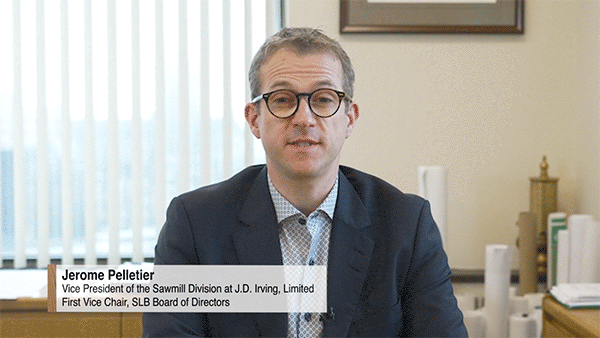HIGHLIGHTS
Program Updates
The SLB Addresses the Wood Education Gap in Engineering Schools
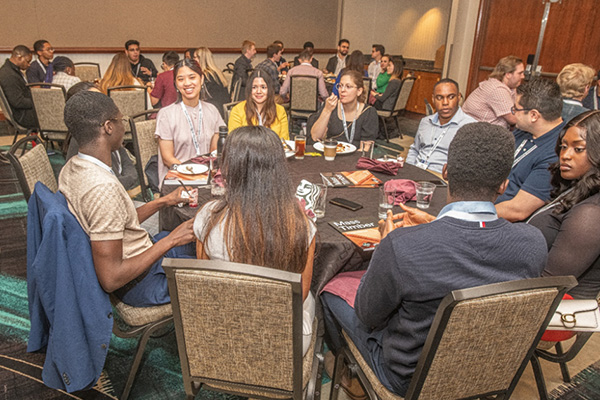
Wood education is critically underrepresented in postsecondary engineering programs across the United States. A National Council of Structural Engineers Associations (NCSEA) survey revealed that while every U.S. civil engineering program requires steel and concrete design courses, only 52% include wood design—and often only as an elective or a minor part of a hybrid course. This gap leaves many future engineers underprepared to leverage wood as a versatile, sustainable building material.
To address this challenge, the SLB sponsored the Young Engineer and Student Lunch at the 2024 NCSEA Structural Engineering Summit, held in Las Vegas from November 5 to 8. This event, the largest annual conference for structural engineering, drew more than 1,000 attendees and provided an unparalleled opportunity for fostering connections and promoting wood design education.
The Young Engineer and Student Lunch brought together more than 120 students, young engineers, and faculty members, offering them a unique opportunity to network with peers and established professionals in the structural engineering community. Participants received copies of the Mass Timber Design Manual, a valuable resource for understanding the environmental and economic benefits of wood construction. By sparking conversations about wood’s potential as a low-embodied carbon material and a critical solution for resilient design, the event inspired attendees to consider wood solutions in their future projects.
This year’s summit also celebrated the profession’s rising stars through the recognition of the Diversity in Structural Engineering Scholarships. Notably, four students who were awarded the SLB-sponsored Wood Solutions Scholarship in June attended the conference as guests of NCSEA, which provided travel stipends to support their participation. This collaboration further extended the impact of the SLB’s investment by enabling the scholars to engage with industry leaders and learn about the latest developments in wood design and structural engineering.
The AWC Continues Commitment to Mass Timber Code Adoption and Education
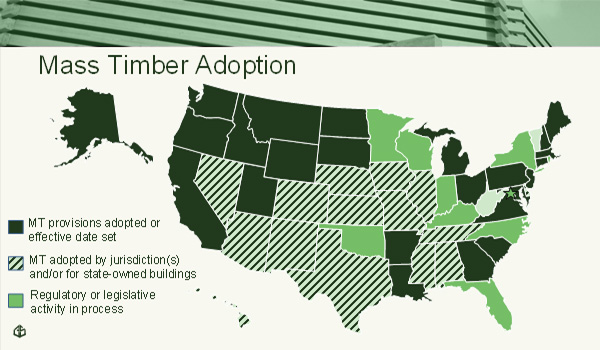
As the 2021 and 2024 International Building Codes (IBC) that included provisions for mass timber continue to be adopted across state and local jurisdictions, the American Wood Council (AWC) is actively supporting these efforts through outreach and education.
To date, 39 states have now adopted the 2021 IBC, including its mass timber provisions, either statewide or in certain jurisdictions. The most recent state to adopt the codes is Michigan, which approved a new 2021 Michigan State Building Code based on the 2021 IBC last year. This new code will go into effect in April 2025. Other states, including New Hampshire, Pennsylvania, and Massachusetts, also adopted updated codes that include mass timber construction last year.
Growing adoption of these codes is having an impact on constructed projects, with 2,338 multifamily, commercial, or institutional mass timber projects in progress or built in the United States as of December 2024.
Before and after a jurisdiction adopts the 2021 or 2024 IBC or a new mass timber–related code provision, the AWC works with local building officials and fire services to ensure that building inspectors and other key personnel are educated on and understand mass timber codes and construction. In 2024, AWC field staff led these types of training sessions across localities in 18 states, ensuring that hundreds of building and fire officials are familiar with mass timber code requirements and the AWC’s resources.
Think Wood Features Wood-Built ADUs to Inspire Builders and Developers
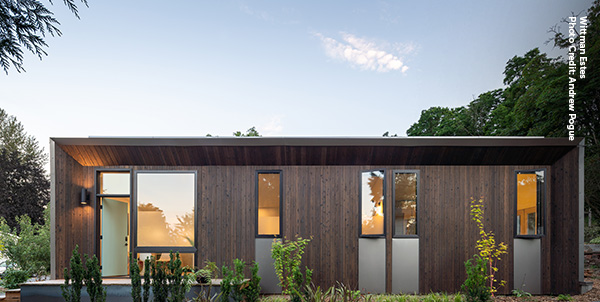
With a tight real estate market and dwindling land supply in many U.S. metro areas, municipalities and nonprofits are looking at accessory dwelling units, or ADUs, as a way to increase the affordable housing base without developing new land. ADUs are growing at 9% annually, one recent study suggests, adding 100,000 units each year in the United States. In a recent blog post, Think Wood put the spotlight on three inspiring ADU projects that make the most out of lumber. The Solar Studio from Wittman Estes, for example, uses a wood structure that is prefabricated off-site and uses charred cedar siding to enhance the visual appeal of the residence and minimize maintenance.
“We were very focused on coming up with an environmentally sustainable, low-carbon solution,” says Seattle-based architect Matt Wittman of Wittman Estes. “It’s constructed using mostly bio-based products and uses very little steel. The structure is all light-frame wood; it uses natural cellulose insulation and charred wood siding.”
Think Wood’s work to protect residential market share has expanded from a primary focus on decking and outdoor applications to include projects that use exposed softwood lumber for appearance wood and cladding to support new areas of market growth; the program is also highlighting how prefabricated light-frame construction provides advantages in terms of cost, speed of construction, and design flexibility. This type of content helps residential contractors, architects, and developers find new uses for wood in homes beyond traditional framing and decking.
56 Mass Timber Installer Training Mock-Ups in Place by Q1 2025
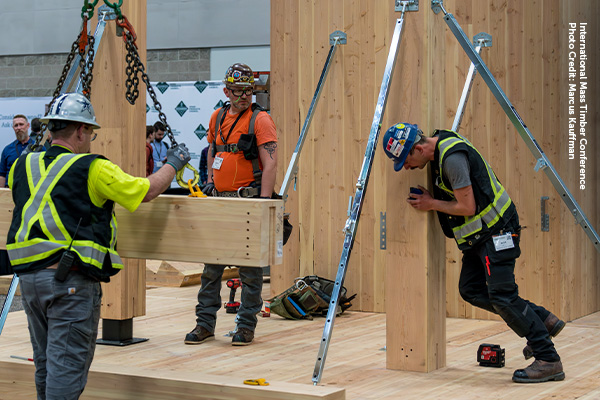
WoodWorks’ mass timber installer training program took another leap forward with the addition of 21 carpenter and ironworker training locations, which are procuring mock-ups from partner mass timber manufacturers using WoodWorks drawings. Those locations began courses in January, for a total of 56 active training course locations across the United States. To date, more than 1,500 students have completed 28,090 hours of mass timber installation training initiated through WoodWorks’ Construction Management program.
Inroads are also being made with steel erectors. WoodWorks recently presented at an ironworkers “Train the Trainer” course in Henderson, Nevada, which taught 22 new instructors to run efficient and effective installation programs at their local training centers. WoodWorks also presented to the Western Steel Council, which is an employer-led association with activities in California, Nevada, and Arizona. Part of their responsibility includes understanding the work involved with mass timber construction, to inform both future labor agreements and member education related to jobs and market trends. The audience included multiple steel erectors who are evaluating the opportunity to pursue mass timber projects.
WoodWorks’ efforts to train construction professionals help to ensure building designs don’t default to concrete or steel because of a lack of trained contractors, an issue identified in SLB and WoodWorks research on obstacles to mass timber construction.
Spotlight
Harvard University Conference Center Highlights Mass Timber’s Higher Ed Potential
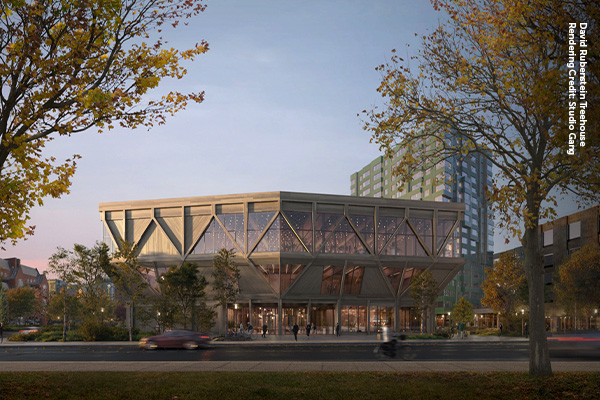
Harvard University’s first mass timber building is a conference center designed to feel like climbing into a treehouse. The David Rubenstein Treehouse conference center, which recently topped out near Harvard’s campus in the Allston neighborhood of Boston, was designed by Chicago-based architecture firm Studio Gang. The firm recently completed two other mass timber higher ed projects: the California College for the Arts expansion in San Francisco, and the Kresge College expansion at the University of California, Santa Cruz, which was profiled by Think Wood.
The Treehouse features a central staircase that highlights the natural beauty of the mass timber structure, according to an article in Designboom. “The sustainably harvested timber structure, also expressed on the facade, defines the Treehouse’s identity as an innovative and environmentally conscious building,” the article says.
The building is one of a growing number of higher ed projects using mass timber to boost well-being and reduce embodied carbon. The rising demand for educational facilities presents a significant opportunity for the lumber industry, with a potential annual market opportunity of 1.7 BBF, according to an outlook prepared for the SLB by Forest Economic Advisors. In addition to Think Wood’s coverage of the sector, WoodWorks is pursuing growth opportunities for wood in new school construction, with 169 projects reported since 2015.
The Treehouse also represents further momentum for mass timber in Boston, where the SLB supported a mass timber accelerator. The program’s final report identified eight active projects totaling over 1.3 million square feet projected to be constructed with mass timber materials and 22 future projects totaling over 4.3 million square feet. The SLB is inviting more cities with strong sustainability goals to join the movement, providing funding and project support to create their own mass timber accelerator programs.
Industry Resources
FEA’s Housing Dashboard
This housing dashboard is provided compliments of Forest Economic Advisors (FEA).
View the December Housing Dashboard
Virginia Tech's Monthly Housing Report
This monthly housing commentary report is a free service of Virginia Tech and is intended to help one gauge future business activity in the U.S. housing market.
November 2024 Reports (released in January 2024)
Part A: November Housing Commentary
Part B: November Economic Conditions


